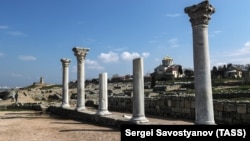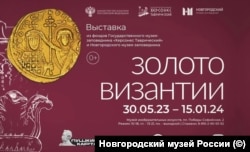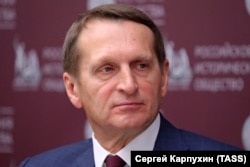Late last month, a new exhibition opened at the Tauric Chersonesos museum complex in the Russian-occupied Crimean city of Sevastopol devoted to artifacts recovered at the Stone Age Kamyana Mohyla site in the occupied part of Ukraine’s Zaporizhzhya region.
At the same time, artifacts from the Tauric Chersonesos preserve are currently on display in the Russian city of Novgorod in an exhibition called Byzantine Gold.
“The exhibition includes more than 200 objects…that clearly testify to the former grandeur of the churches of Chersonesos and Novgorod,” reads the museum’s summary of the show.
Such exhibitions are just recent instances of the transfer of priceless artifacts by Russian occupying forces around different parts of Ukraine currently under their control or to Russia itself, a process Ukrainian experts say is a nearly unprecedented case of cultural expropriation that amounts to a war crime.
“Russia’s actions fall under the definitions of ‘illegal transfer’ and ‘illegal appropriation,’” said Denys Yashniy, a researcher at the Kyiv-Pechersk Lavra, or Monastery of the Caves.
“All of the illegal manipulations of the occupiers with Ukraine’s cultural heritage, particularly with Tauric Chersonesos and Kamyana Mohyla, violate not only Ukrainian law but also international law,” Borys Babin, a professor of international law and former Ukrainian presidential representative for Crimea, told RFE/RL’s Crimea.Realities in February. “Particularly, the Geneva Convention on the inviolability of cultural heritage and the norms of the 1954 Hague Convention on the Protection of Cultural Property in the Event of Armed Conflict.”
Russian efforts to “transform the historical significance of captured Ukrainian monuments” are part of an “obvious intention of genocide toward the Ukrainian people and a gross violation of the 1948 UN Convention on Genocide,” Babin said.
The Inter-Museum Working Group
Russia has been “intentionally and purposefully” expropriating Ukraine’s cultural heritage since the occupation of Crimea in 2014, said Ukrainian cultural and political commentator Yevhen Savisko.
“Russia not only wants to cause Ukraine material harm but also to destroy layers of culture in the Crimea region,” he added. “This is necessary for the rewriting of the history of the ethnic groups who have lived and who are living in Crimea.
“And all this is being done at the orders of the highest leadership of the Russian Federation,” he continued. “The organization and coordination of the illegal seizure of museum objects from Crimea has been undertaken at least at the level of the Russian Culture Ministry and the central apparatus of the [Federal Security Service (FSB)].”
Crimea and the parts of southern Ukraine around the Azov Sea and the Dnieper River have been occupied since prehistoric times by a mosaic of Greek, Turkish, Scythian, Germanic, Roman, and Slavic peoples.
“This is simply an incredible, interesting territory that played an important role in the history of the population that lived on the territory of Ukraine,” said Serhiy Nemtsev, the former head of the archaeological museum at Kherson State University. “The Zaporizhzhya Cossacks are just the last point in a long chain of cultures and societies that existed on these shores.”
The Russian effort to manipulate the cultural heritage of the occupied parts of Ukraine has been overseen by the Russian Historical Society (RHS), which has been headed since 2012 by Sergei Naryshkin, a close associate of President Vladimir Putin with a KGB background who has also headed Russia’s Foreign Intelligence Service (SVR) since 2016.
'Nothing In Common'
Shortly after Russia’s massive invasion of Ukraine in February 2022, the RHS set up an “inter-museum working group” that focused on the occupied parts of Ukraine’s eastern Donetsk and Luhansk regions and aimed “to show the historically inseparable connection of the region with Russia” through “unique materials from the fund collections of museums and archives,” according to the working group’s application for funding from the Russian Presidential Fund of Cultural Initiatives in September 2022.
During a meeting with Putin in Moscow in November 2022, Artyom Rubchenko, the RHS representative in the occupied Ukrainian city of Luhansk, summarized the working group’s activity.
“It is made up of leading professionals -- museum workers from the leading museums of the Russian Federation and university instructors,” Rubchenko said. “This group has been working since April and about 20 people have participated in it. During trips to the territories where the main events of this year have happened, more than 4,000 items have been collected. Many of them are already being studied, and on the basis of these collections we have already opened four exhibitions in major Russian museums.”
In comments to Interfax in July 2022, Naryshkin proposed the study of ancient fortifications in eastern and southern Ukraine “which were built by Russians and Little Russians for the defense of their common fatherland, our Russia.”
“Little Russians” is an anachronistic and offensive term for Ukrainians.
All objects uncovered during the research, Naryshkin said, must be “included in the unified state register of the cultural heritage of the peoples of the Russian Federation.”
In November 2022, the RHS established the administrative oversight of the Tauric Chersonesos museum complex in Sevastopol, which documents the ancient Greek settlement of Crimea, over the paleolithic Kamyana Mohyla in the Zaporizhzhya region.
“No historian, archaeologist, or culturologist would be able to provide a conscious explanation for such a combination,” wrote Ukrainian archaeologist Evelina Kravchenko in an article in January. “All the sites at these respective reserves…belong to completely different social groups and have nothing in common either in history, archaeology, or architecture.”
Instead, Kravchenko contended, the move is dictated by Russia’s desire to attribute to Kamyana Mohyla the “fake meaning” of “the alleged cradle of Russian Orthodoxy.”
'Colossal' Losses
“We can say that a shipment of weapons has arrived in Ukraine,” said an announcement by Ukraine’s Culture Ministry on October 20. The ministry was announcing the return to Ukraine of 14 “ancient weapons from the Eneolithic to the Middle Ages” by the United States.
It was not immediately clear whether the objects were stolen from museum collections or whether they were discovered by looters using metal detectors in the Russian-occupied parts of Ukraine -- a practice that has been thriving since the catastrophic breach of the Kakhovka dam in June and the subsequent draining of its reservoirs. The United States alone has confiscated more than 20 groups of items looted in Ukraine and illegally smuggled out of the country.
“The area flooded by the hydropower plant was the umbilical cord of the Cossacks,” said Ukrainian historian Oleksandr Alfyorov, discussing the importance of sites in the Zaporizhzhya region in early Ukrainian history. “The flooded territories were not only the heart of Zaporizhzhya but also important for Kyivan Rus as it expanded its historical range.”
Now, Ukrainian historians say, many previously unexplored or underexplored sites are vulnerable to uncontrolled looting. Many items, they fear, could even end up being melted down as scrap metal by people unaware of their significance.
Kateryna Shtepa, an analyst with the Kyiv Institute of State Relations, said it is easiest for Ukraine to recover historical objects when they are smuggled abroad. In June, the Dutch Supreme Court upheld a government decision to return to Ukraine a trove of Scythian gold artifacts that were on display in Amsterdam from a Crimean museum when Russia occupied the peninsula. Moscow had been seeking to have the treasures sent to Crimea.
“The items were returned to Ukraine, where there is a legitimate government,” Shtepa said. “On the basis of this case, it may be possible to return other stolen objects if they are on the territory of third countries.”
Analyst Savisko noted that Moscow routinely ignores the decisions of international courts, which means that recovering items taken to Russia will be virtually impossible.
“And searching for stolen items on the territory of such a huge country is not possible,” he said. “Unless some nice items show up in prominent Russian museums.”
Items that have been newly discovered since the Russian occupation and so have not been catalogued by Ukrainian scholars will likely never be recovered or studied properly, Savisko added.
“The losses can only be described as colossal,” said historian Yashniy. “But how much exactly, no one can say.”
On November 4, 2022, Putin addressed Russian historians and Orthodox clergymen at Moscow’s Manezh exhibition on National Unity Day holiday. Without providing evidence, Putin repeated his claim that the West had been trying to turn Ukraine against Russia since the collapse of the Soviet Union in 1991.
“If someone wants to deprive a state of sovereignty and turn its citizens into vassals,” he said, “they begin precisely by revising the history of the country in order to deprive people of their roots and doom them to unconsciousness” -- something critics say Putin himself is trying to do to Ukraine.
















